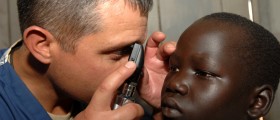
Crossed eyes
For the most part, the exact cause of the eye misalignment is not completely known. There are six muscles that exist in order to control the movement of the eyes. Two of these muscles deal with lateral movement, while the remaining muscles are concerned with vertical and tilting movment. In order to successfully focus the eyes, all of the eye muscles must work together in order to fully control the movement and position of the eyes. These muscles are controlled by the brain. Cataracts or eye injuries can also lead to the onset of strabismus.
It can be difficult to completely identify the differences between crossed eyes and true strabismus. It is common for young children to have a nose shape that can lead to the eyes appearing to be crossed. Ophthalmologists are capable of distinguishing between true strabismus and this optical illusion. The latter will generally resolve as childhood progresses. It might be necessary for a child to undergo visual screening by a pediatrician, family doctor, or ophthalmologist, after birth.
Treatment goals include the preservation of vision, the straightening of the eyes, and the restoration of three dimensional vision. If the problem is discovered in the early years of life, then treatment is often successful. Delayed treatment can lead to permanent problems. Early surgery is often recommended when it comes to strabismus in infants. Strabismus surgery requires a small incision to be made in the eye tissue. This will allow the ophthalmologist to access underlying muscles in the eye. During surgery, the eyeball is not removed from the eye at any point. In the surgery, the eye muscles are repositioned in one or both eyes.

















Your thoughts on this
Loading...